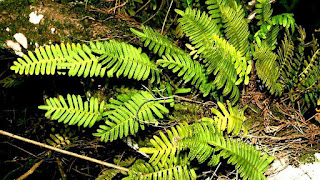Pleopeltis polypodioides (syn. Polypodium polypodioides), also known as the resurrection fern, is a species of creeping, coarse-textured fern native to the Americas and Africa.
Video Pleopeltis polypodioides
Description
The evergreen fronds of this fern are 25 cm high by 5 cm wide and monomorphic. The leathery, yellow-green pinnae (leaflets) are deeply pinnatifid, oblong to narrowly lanceolate, usually widest near middle, occasionally at or near base. It attaches to the limbs of its host plant with a branching, creeping, slender rhizome, which grows to 2 mm in diameter. The scales are lanceolate, with light brown base and margins, and having a dark central stripe.
The gametophytes (the haploid gamete producers) of this plant develop from very small spores that float in the air and are deposited on moist tree branches. These spores are produced in sporangia that develop on the leaves of the fern's sporophyte. The fern can also reproduce by the division of its rhizomes.
On the underside of the blades, the sori (reproductive clusters) are round, discrete, and sunken. Their outline can be seen as raised dimples on the upper surface. They are typically near the outer edge, and occur on all but the lowest pinnae of fertile fronds. Indusium is absent. Sporangia are yellow to brown at maturity. Spores are produced from summer to fall.
Maps Pleopeltis polypodioides
Habitat and water absorption
This fern is an epiphyte, or air plant, which means it attaches itself to other plants and gets its nutrients from the air and from water and nutrients that collect on the outer surface of bark. The resurrection fern lives on the branches of large trees such as cypresses and can often be seen carpeting the shady areas on limbs of large oak trees. However, it is known to grow on the surfaces of rocks and dead logs as well. It is often found in the company of other epiphytic plants such as Spanish moss.
The P. polypodioides resides in the hardwood forests of southeastern United States in areas including Delaware, Illinois, Texas, and Florida. This fern can also be found in areas such as subtropical America and parts of southern Africa.
The resurrection fern gets its name because it can survive long periods of drought by curling up its fronds and appearing desiccated, grey-brown and dead. However, when just a little water is present, the fern will uncurl and reopen, appearing to "resurrect" and restoring itself to a vivid green color within about 24 hours. It has been estimated that these plants could last 100 years without water and still revive after a single exposure.
When the fronds "dry", they curl with their bottom sides upwards. In this way, they can rehydrate the quickest when rain comes, as most of the water is absorbed on the underside of the leaf blades. Experiments have shown that they can lose almost all their free water--up to 97%--and remain alive, though more typically they only lose around 76% in dry spells. For comparison, most other plants would die after losing only 8-12%. This fern can lose almost all the water not hydrating the cells in its leaves and survive. When drying, the plant synthesizes dehydrins, which allow the cell walls to fold in a way which can be reversed later.
At least one study has shown association between P. polypodioides and moss, indicating that this fern may rely on moss for some of its water needs.
Reproduction
The fern has spores on the bottom of the fronds, contained in sori. The fern sporulates in Summer and early Fall. Rhizome sections are also viable offspring and can root themselves in new medium.
Of note
The resurrection fern is also known by the common names of little gray polypod, scaly polypody and miracle fern.
This plant has been taken on a space shuttle mission to watch its resurrection in zero gravity.
See also
- Resurrection plant
References
- Flora of North America: Pleopeltis polypodioides var. michauxiana
- USDA Plants Profile: Pleopeltis polypodioides
- Flora of Zimbabwe: Polypodium polypodioides subsp. ecklonii
- Polypodium polypodioides from the Hardy Fern Library.
- Moran, Robbin C., A Natural history of Ferns. Timber Press (2004).
- The Relationship Between Pleopeltis polypodioides (Polypodiaceae) and Associated Mosses By John W. Story II
Source of article : Wikipedia

